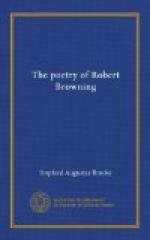And then, beyond all these matters of form, there is the poet himself, alone among his fellows in his unique and individual power, who has fastened himself into our hearts, added a new world to our perceptions, developed our lives and enlarged our interests. And there are the separate and distinguished excellences of his work—the virtues which have no defects, the virtues, too, of his defects, all the new wonders of his realm—the many originalities which have justly earned for him that high and lonely seat on Parnassus on which his noble Shadow sits to-day, unchallenged in our time save by that other Shadow with whom, in reverence and love, we have been perhaps too bold to contrast him.
FOOTNOTES:
[1] I state it roughly. The Poems of Two Brothers appeared in 1826, Tennyson’s first single volume in 1830, his second in 1833, his last in 1892. Browning’s first poem was issued in 1833, his last in 1890. Paracelsus, in which his genius clearly disclosed itself, was published in 1835, while Tennyson, seven years later, proved his mastership in the two volumes of 1842.
[2] A Death in the Desert touches on the doubts which, when it was written, had gathered from historical criticism round the subject matter of the Gospels, but the prophetic answer of St. John is not critical. It is Browning’s personal reply to the critics, and is based on his own religious philosophy. The critical part of the argument is left untouched, and the answer is given from the poet’s plane. It is the same when in the Parleyings with Certain People Furini is made to embody Browning’s belief in a personal God in contradistinction with the mere evolutionist. He does not argue the points. He places one doctrine over against the other and bids the reader choose. Moreover, he claims his view as his own alone. He seeks to impose it on no one.




